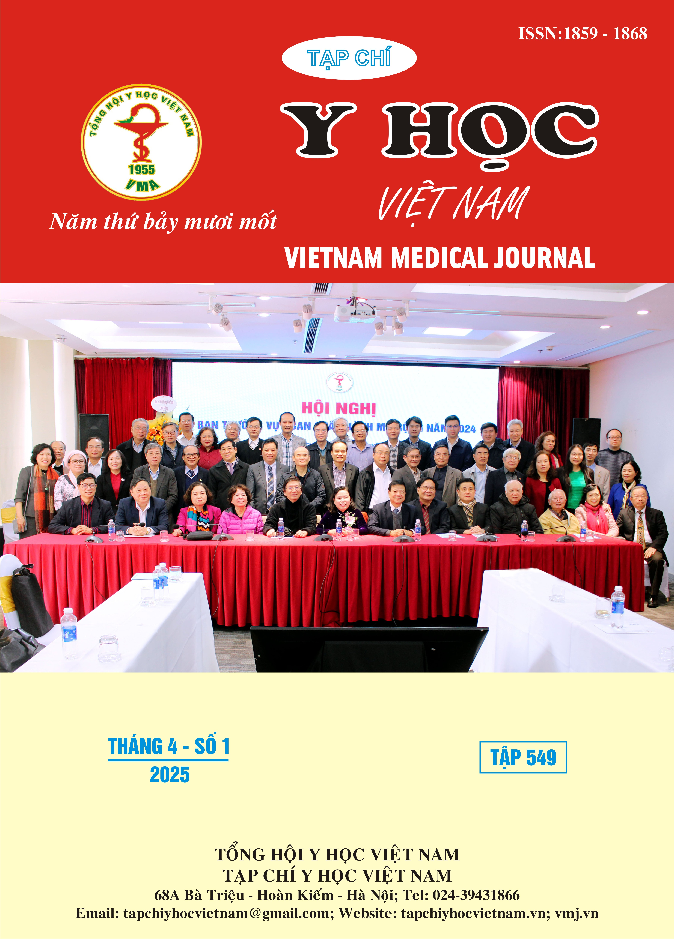KHẢO SÁT NỒNG ĐỘ BETA-CROSSLAPS Ở BỆNH NHÂN ĐAU XƯƠNG KHỚP TẠI BỆNH VIỆN STO-PHƯƠNG ĐÔNG
Nội dung chính của bài viết
Tóm tắt
Mục tiêu nghiên cứu: Khảo sát nồng độ Beta-Crosslaps trên các bệnh nhân có triệu chứng đau xương khớp và mối liên quan, vai trò của Beta-Crosslaps trong chẩn đoán và điều trị các bệnh xương khớp. Đối tượng và phương pháp nghiên cứu: Đối tượng gồm 1290 người đến khám tại bệnh viện STO Phương đông từ 1/1/2018 đến 30/12/2024, được chia thành 2 nhóm: Nhóm chứng: 609 người khỏe mạnh, không có các triệu chứng về bệnh xương, khớp. Nhóm bệnh: 681 bệnh nhân đi khám vì lý do có triệu chứng đau xương khớp. Phương pháp nghiên cứu: mô tả cắt ngang. Các đối tượng được thu thập thông tin bao gồm tuổi, giới tính, tình trạng đau xương khớp và thực hiện xét nghiệm định lượng trên máy miễn dịch tự động Cobas 411 thuốc thử, calibrator và control của hãng Roche Diagnostic. Phân tích số liệu trên phần mềm STATA 14.0, so sánh giá trị trung bình của Beta-Crosslaps giữa các nhóm tuổi và nhóm giới tính với phép kiểm định t-test và one-way Anova so sánh hai nhóm độc lập và nhiều nhóm độc lập có phân phối chuẩn. Kết quả: Nồng độ Beta-Crosslaps tăng lên theo tuổi ở cả nam và nữ trong các nhóm chứng và nhóm bệnh.Tuy nhiên sự so sánh này không có ý nghĩa thống kê giữa hai lứa tuổi 50-70 và >70. Ở nhóm chứng nồng độ Beta-Crosslaps ở nam cao hơn nữ trong tất cả các lứa tuổi nhưng ở lứa tuổi >70 không có ý nghĩa thống kê. Ở nhóm bệnh lứa tuổi <50 nồng độ Beta-Crosslaps ở nam cao hơn nữ nhưng ở các lứa tuổi 50-70 và >70 thì ở nữ lại cao hơn nam. Trong cùng giới tính và cùng nhóm tuổi, các bệnh nhân thuộc nhóm bệnh có nồng độ Beta-Crosslaps cao hơn của nhóm chứng. Kết luận: Kết quả nghiên cứu hồi cứu khảo sát sơ bộ về nồng độ Beta-Crosslaps ở bệnh nhân đau xương khớp cho thấy nồng độ Beta-Crosslaps tăng theo tuổi và tăng trong nhóm bệnh nhân đau xương khớp. Các bệnh nhân đau xương khớp có tăng quá trình hủy xương, gây nguy cơ loãng xương và vì vậy nên điều trị dự phòng loãng xương cho các bệnh nhân này. Cần có các nghiên cứu sâu hơn về sự thay đổi của Beta-Crosslaps trong các bệnh xương khớp khác nhau.
Chi tiết bài viết
Tài liệu tham khảo
2. Salve HR, Gupta V, Palanivel C, Yadav K, Singh B. Prevalence of Knee Osteoarthritis Amongst Perimenopausal Women in an Urban Resettlement Colony in South Delhi. Indian Journal of Public Health. 2010;54(3):155. doi:10.4103/0019-557x.75739
3. Musey PI, Linnstaedt SD, Platts‐Mills TF, et al. Gender Differences in Acute and Chronic Pain in the Emergency Department: Results of the 2014 Academic Emergency Medicine Consensus Conference Pain Section. Academic Emergency Medicine. 2014;21(12): 1421-1430. doi:10.1111/acem.12529
4. Vasikaran S, Cooper C, Eastell R, et al. International Osteoporosis Foundation and International Federation of Clinical Chemistry and Laboratory Medicine Position on Bone Marker Standards in Osteoporosis. Clinical Chemistry and Laboratory Medicine (Cclm). 2011;49(8):1271-1274. doi:10.1515/cclm.2011.602
5. Khosla S, Riggs BL, Atkinson EJ, et al. Effects of Sex and Age on Bone Microstructure at the Ultradistal Radius: A Population-Based Noninvasive in Vivo Assessment. Journal of Bone and Mineral Research. 2006;21(1):124-131. doi:10.1359/jbmr.050916
6. Vanderschueren D, Venken K, Ophoff J, Bouillon R, Boonen S. Sex Steroids and the Periosteum—Reconsidering the Roles of Androgens and Estrogens in Periosteal Expansion. The Journal of Clinical Endocrinology & Metabolism. 2006;91(2):378-382. doi:10.1210/jc.2005-1766
7. Fugaru O-F, Șerbănescu M-S, Stefan LI, Trăistaru MR. Beta-Crosslaps in Knee Osteoarthritis – Assessment and Rehabilitation. Balneo and PRM Research Journal. 2024;15 (Vol.15, no.1):673-673. doi: 10.12680/balneo. 2024.673
8. Montoya MJ, Giner M, Miranda C, et al. Microstructural Trabecular Bone From Patients With Osteoporotic Hip Fracture or Osteoarthritis: Its Relationship With Bone Mineral Density and Bone Remodelling Markers. Maturitas. 2014; 79(3): 299-305. doi:10.1016/j.maturitas.2014. 07.006


